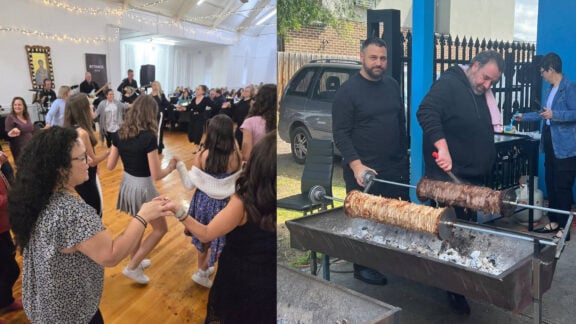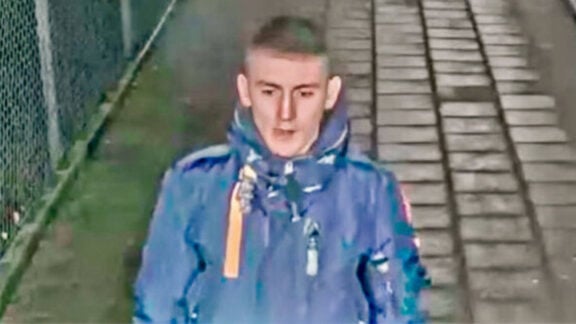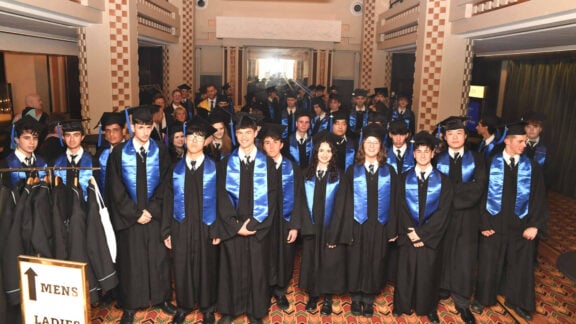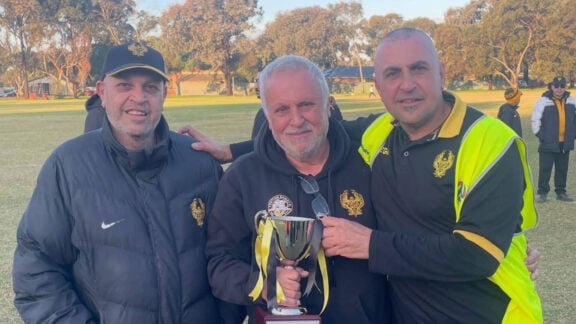Along the wall that faces the desk of John Hatzistergos’ chambers in the District Court of Sydney stands a shelf filled with rows of dense law books. It’s what you would expect in a judge’s chambers, but not far from the legal tomes is a blown-up black and white photo of a family.
The father sits with one arm around a young boy of about three years old. Standing to his right is the eldest daughter who looks about 10. The mother seated next to the father holds a baby. She is wearing a black scarf around her head and a long dark dress with black shoes and stockings. To the left of the mother are two young boys around five and six years whose pants are dirty and shoes scuffed.
The photo encapsulates the story of thousands of Greek migrants who came to Australia in the 1950s. One of the boys with the scuffed shoes is John Hatzistergos’ father.
“It’s hard to not be moved by that picture,” the judge tells Neos Kosmos.
“Times were tough in Kos after the war, things were desolate in a country that was devastated by war. Many people came out here for the postwar reconstruction, and they had opportunities. My mother, when she first arrived, worked in a factory. My father worked in a small goods factory, then he had a shop and owned his own business. He has passed on now. They were humble beginnings but they were pleasant.”
Many Greeks in the 1950s lived in the inner city suburbs of Sydney, as did the Hatzistergos family, with the judge spending his formative years in Redfern and Surry Hills. He attended Bourke Street Public and Cleveland Street Boys High and even though the biggest non-English group were Greeks, he still grew up experiencing a clash of cultures.
“Being a young person of Greek origin that didn’t speak a word of English when I went to school, you were doing a whole range of things that distinguished you from the predominant culture,” he says.
“I hesitate to say this, but the reality is that you were uncomfortable about your origins, and you asked ‘Why me? Why am I in this?’ The level of acceptance was not what it is today. We were seen as different. When you see people as different, some people are afraid about what that difference meant. There tended to be a situation where there were barriers between students. But that broke down with time.”
Hatzistergos represented the Australian Labor Party between 1999 and 2011 in the NSW parliament, and held various minsterial portfolios including Justice, Health, and Regulatory Reform, and was NSW Attorney General from 2007 until 2011.
During his maiden speech, Hatzistergos paraphrased Greek American journalist, commentator and former US Democratic advisor George Stephanopoulos.
“I said, the role of Greeks, and it wasn’t my words, was not to blend in, it was to stand out,” he reflects.
“It wasn’t to change our name, it was to make our name. The great aspirations of the migrants that came to this country, including my parents, was to get a good education and to use that education. They may have been cobblers, waiters and cooks, but it was to get their kids educated and to use that education to become professors, doctors and lawyers. In the late 70s when I left school, we were a small year 12 class but predominately Greek, and just about all of [us] went to university.”
Hatzistergos was honoured to received an Order of Australia as a Member in the General Division (AM) for his significant service as a minister and to the legal profession, but he says his story is not unique.
“I was not the only person of Greek background who managed to get into the honours list,” he says.
“Yes, it was a humbling surprise. The thing I have reflected on most is, in the course of my working life to this point, the thousands of people who have joined me in my journey.
“Just a whole range of different people who have all walked with me in some respect and been a part of it. You don’t achieve anything by yourself, people like to think that, but you don’t. You’re dependent on others.”
After 12 years in the NSW Parliament, Hatzistergos retired from politics in 2011. During his time in government there were many notable achievements. The examples he cites include reform of Freedom of Information laws and electoral funding; he also established the Information and Privacy Commission, set up a Royal Commission into Child Welfare, and saw significant changes to the way the Children’s Court operated. He was involved in the establishment of NSW’s 135-bed Forensic Hospital, the first standalone institution in that state where people deemed not guilty due to mental illness could be accommodated outside of the normal prison system. He oversaw the introduction of a disciplinary regime for non-accredited health providers, as well as significant redevelopment of major teaching hospitals.
But there is one public work that stands out the most for him. “The proudest thing was the work I did for asbestos victims, when the James Hardie issue arose,” he says.
“In particular, when the fund was drying up and it was necessary for us to secure the asbestos trust fund so that it had sufficient resources to be able to meet future claims for victims. That was an important reform that took a lot of work, not only on my part, and I was quite proud of that.”
On 10 October 2014 Hatzistergos was appointed as a judge of the District Court of New South Wales, and it’s a role he describes as “intense”.
“Our job involves being socially aware at all levels and being cognisant of those matters. We exercise judgement, but it’s not blind justice,” he says.
“You try and do your best in everything you do and that requires often a lot of reflection and cool-headedness. Part of the role that I have to perform involves an understanding of different circumstances. There are many people who come in to our courts whose first language is not English. Think about it. If you were in their country in a criminal trial being cross-examined and examined by foreign lawyers in a language that you don’t understand – that’s not easy.”
He may have held prominent positions in politics and law but Hatzistergos doesn’t view himself as a role model although he does take his role as a mentor seriously.
“The reason I say that I am not a role model is because all lives are an adventure,” he says.
“Part of the adventure is giving young people the knowledge and confidence to be able plan their own roadmap. In this phase of my working life I have sufficient background and experience to be able to give something to others. After I left parliament I’ve taught at the University of Technology Sydney. When lecturing at universities, I tell my students what you will learn in your class here is some basic concepts that you will use, but the most important aspect that happens from this point is not what you learn, but how you use what you’ve learned, and creativity is an important aspect of the educational experience.”









